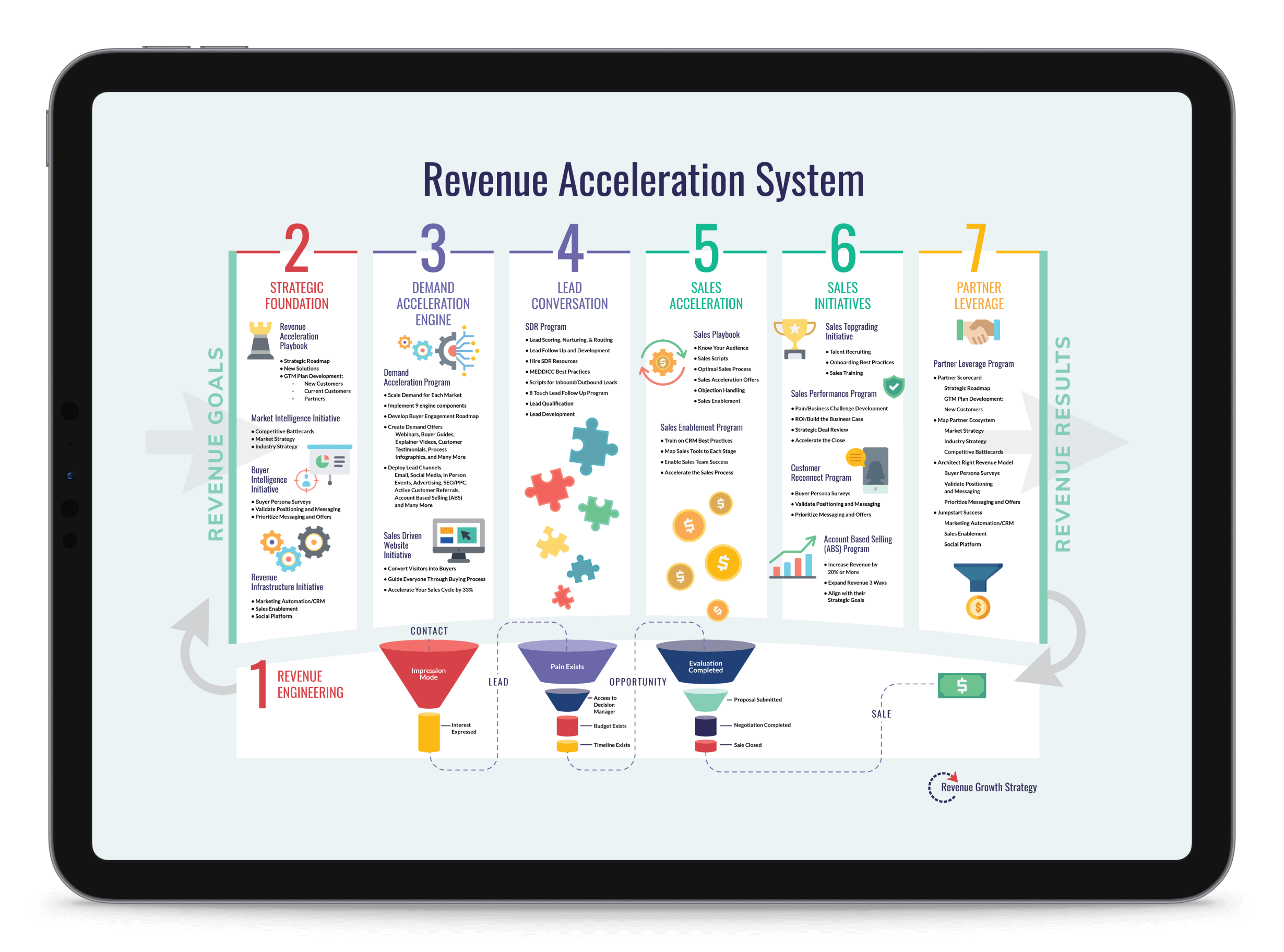Most companies, intentionally or not, have a competing strategy instead of a winning strategy when it pertains to their target markets. Often when I talk with a CEO, they ask me to explain the difference. If you have a competing strategy you focus on selling your services or solutions into your target markets.
The acceptable outcome is getting more opportunities closed and having more customers than before. If you have a winning strategy, you intentionally execute a plan to engage 100% of your target market so everyone can understand your value and engage.
Achieve predictable revenue growth of 25% or more in your B2B business this year
Get my detailed infographic to see how you can follow my unique framework to scale your business, step-by-step. Click below to download the Ultimate Revenue Acceleration Guide.
There are 4 steps you can take today to win your target markets.
1. Be Intentional About Your Approach
Start with the intention that you want to reach your entire audience. As I worked with one client focused on serving property management companies, I asked them how many companies were in their target market. They did not know but assumed 10,000. Upon further investigation we were able to ascertain the accurate number and get intentional with our plan.
2. Reach 100% of Your Target Audience
As I have traveled North America and conducted revenue growth workshops in every major city, I often ask Executives what percent of their target audience they are engaged with today. Often, the response is the same – 5 to 10%. That to me is astounding because that means that 90 to 95% of their target audience cannot buy from them!
Another reason why you need a complete coverage strategy is that 5-10% of your target audience is typically in a position to buy your type of solution or service every year. The challenge is you don’t know which 5-10% are in the position unless you have an intentional plan to reach everyone.
There are excellent databases available today that should provide you with all of the contacts and associated contact information for your target audience, including ZoomInfo and Apollo.io.
These databases are constantly updated with new contacts and reflect changes with current contacts. In some situations, you may not be able to get what you need from these sources; this happened to me recently when a client wanted to reach the franchisor market. So, in this situation, my team built all of the contacts for the entire franchisor market.
3. Engage with Valuable Offers
Understand what your audience wants from you. They may want to hear about industry’s best practices or learn about the success with their peers. They may want to attend a thought leadership topic of high importance in their field. They may want to understand how to fix or address systemic problems that they face every day.
In order to open the door your content and offers need to be focused on what your buyer wants instead of on your services and solutions.
4. Segment Your Target Audience
You will not succeed with a “one size fits all” approach. While your service or solution may be the same, your buyer always sees themselves as unique. As an example, Geoffrey Moore’s technology adoption lifecycle presents four types of buyers for a technology – innovators, early majority, late majority and laggards.
If you have a new solution, innovators are always open to trying new solutions or services. They are open to the risk associated with being an early adopter. For this group, you want to enable their self-sufficiency.
The next group is the early majority. They are sold on the fact that you can prove and deliver value and what your insight or implementation supports.
The next group is the late majority. They want you to eliminate risk, and you may need to offer a managed services option for this group where you present the service or outcomes.
The last group, the laggards, are looking for everyone else to adopt first and may grudgingly move forward with your service or solution when they perceive that it is the industry standard.
The point here is that you need to package and present your offerings differently to each segment of your audience.
One company that I work with is a leader in social media management services. They offer a robust set of social media management services to help Fortune 2500 companies engage with their audience.
What I found fascinating is each head of social media only wanted to understand what social media best practices were used in their industry. The social media lead at Starbucks wanted to focus on the food and beverage industry. The social media lead at Macy’s wanted to focus on the retail industry. Once I understood their preference, I developed a focused strategy to penetrate and win 12 industries.
These four steps provide you with an intentional roadmap to win your target markets. There is a significant reason why you want to achieve this goal; it makes your company much more valuable when you become the undisputed winner in any given market or segment.
If you value what I have shared in this blog, download my Revenue Acceleration System here, which includes a detailed infographic to see how you can follow my unique framework to scale your business, step-by-step.



